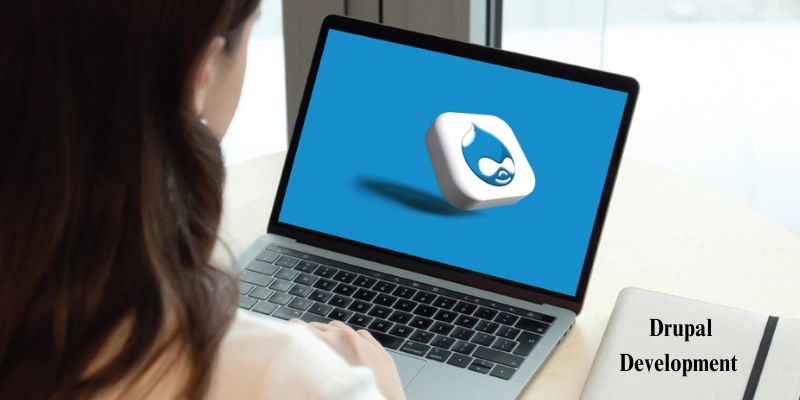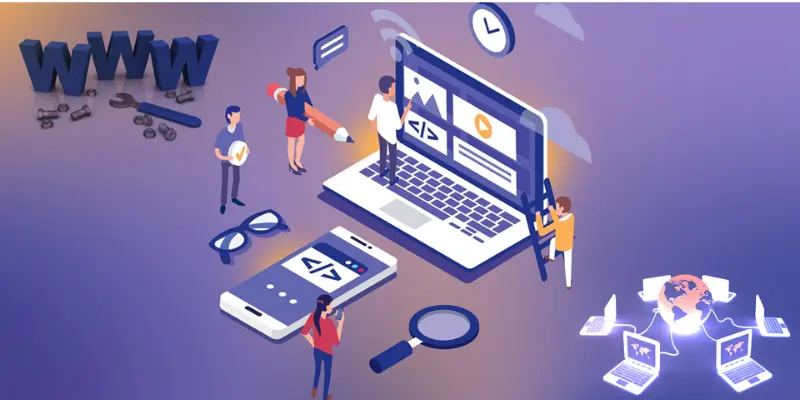The digital landscape is constantly changing; the internet isn't an instance of this. With 2024 just around the corner, Drupal, a world-renowned CMS or content management system (CMS),continues to establish new standards by innovating and shaping the future of web development.
At the beginning of a new year with a fresh calendar, most of us make targets for our resolutions and achievements. Digitally, Drupal sites are on top of the latest developments and provide the most engaging user experiences online.
Drupal offers endless opportunities for creativity, fresh ideas, new concepts, and fantastic functionality because it is an ever-changing CMS accessible on the web. Drupal continues to evolve and push boundaries in Drupal design and development. This article will discuss the significant Drupal advancements for 2024. These developments are causing an influx of attention in the area and opening the door to a fresh digital future for the web.
Brief Overview and Trends of Drupal Development
Web-based development is a term used to describe Drupal as a flexible and powerful CMS that manages content (CMS). It has constantly been developed to accommodate changing requirements in the modern world.
In summary, Drupal is a free-of-cost platform praised for its scalability, adaptability, flexibility, and customization capabilities. In the past, Drupal has been used to build many sites, from tiny to massive companies, providing users with a simple and efficient process for handling information.
In today's ever-changing technology field, keeping current with current trends is vital. In 2024, it is vital to stay updated on the latest developments within Drupal technology. As technology evolves regularly, taking advantage of the latest advancements in Drupal development will guarantee that sites are up-to-date and feature the newest technology.
If you're considering adopting decoupled headless structures integrating artificial intelligence or creating innovative web-based applications, keeping up to date with the constantly evolving development environment of Drupal helps designers come up with creative solutions.
This article will explore the top Drupal advancement trends for 2024 in the continually changing digital age. The blog will shed an understanding of the significance of each and the way they will impact the progress of development on the web using the robust CMS.
Decoupled Drupal
Explore the possibilities of web development decoupled Drupal, which represents a paradigm change in architecture that aims to eliminate the monolithic framework of CMS systems that manage content. Decoupled architecture, called headless Drupal, unifies users' interfaces and the management system that manages the content.
Contrary to traditional CMS configurations in which the display and storage of data are closely connected and uncoupled, Drupal allows both components to be decoupled and permits developers to design an interface for users and methods for providing the content.
One of the main benefits of decoupled Drupal is its ability to adjust to various techniques for both its front and back end—the latest JavaScript frameworks like React or Angular and Vue.js for the front end. Drupal serves as a reliable content backend repository. The flexibility of Drupal is crucial in the present environment of multiple technology platforms that require an individual user's experience.
However, this freedom of design can be a source of problems. It can lead to issues such as synchronization problems between the back and front ends. Maintaining can be a challenge because adjustments or modifications at one point may need identical adjustments at another.
The balance between complexity and flexibility should be carefully considered, considering your project's specific needs against any potential disadvantages.
Headless Drupal
An entirely new way of managing content changes how we handle content. This is because it separates from the display on the front end with the repository at the back end of the content. This differentiates the content creation and storage portion (the backend) from how information is displayed and interacts with (the front part).
The breakaway from a single framework provides developers unprecedented flexibility, allowing them to choose the most appropriate technologies for front and backends separately.
With 2024 nearing, the advantages of using Headless Drupal are becoming more evident. It allows developers to create fluid and immersive experiences across multiple devices and platforms. Due to the growing use of multiple digital touchscreens, from phones to voice-activated assistants, Headless Drupal provides users with a unified and designed user experience.
Artificial Intelligence (AI) Integration
Artificial Intelligence (AI) integration in Drupal development signifies the dawn of dynamic, innovative, advanced web-based user experience. Within the Drupal framework, AI is a transformative power that improves the functionality of websites and user interactions in many ways.
Integrating AI algorithms within Drupal provides for advanced analysis of data, as healthy pattern recognition and decision-making, giving developers the necessary tools to build a more custom and user-friendly digital environment.
The most crucial element of AI integration in Drupal is the capacity to tailor content with AI. With sophisticated algorithmic techniques, Drupal websites can analyze users' preferences, behavior, and interactions to personalize the experience and content automatically.
The personalization goes beyond static content to ensure that each user gets a unique experience when visiting the website. It does not only increase the satisfaction of users but also increases the number of conversions and engagement.
Additionally, chatbots, virtual assistants, and even chatbots can be considered actual software that uses AI within Drupal. Drupal community. AI-powered chatbots offer instant interaction and provide users with quick help, assistance, details, and other features.
Chatbots that use neural processing technologies can deal with customers' queries and improve user interactions. Thanks to machine learning, virtual assistants adapt to the seasons and better comprehend the user's requirements, desires, and preferences, allowing users a more personalized and similar human interaction.
Progressive Web Apps (PWAs) made possible by Drupal
Progressive web applications (PWAs) are now the basis of the modern web, changing the user experience by combining the most efficient characteristics of web and mobile apps. Their increasing significance stems from the necessity for quicker, more efficient, reliable, and exciting user experiences across diverse gadgets.
PWAs use web technologies to deliver an app-like experience that allows users to access information quickly, even in slow-speed circumstances.
Integrating PWAs aligns with the platform's mission of innovation and flexibility within the Drupal framework as a reliable CMS. Drupal plays a crucial role in PWA development because it is the repository behind all information and provides a secure and flexible foundation for dynamic web-based applications.
Drupal's flexibility allows developers to develop APIs that can seamlessly interface with the interface on the front end of PWA and guarantee a seamless transfer of information and data.
The results of PWA implementations that Drupal powers have been aplenty, demonstrating its ability to fulfill the needs of today's internet users. Businesses like entertainment, e-commerce, and news have embraced PWAs made possible through Drupal. They offer fast-loading, flexible, and engaging user interfaces.
The applications use Drupal's functions for managing content and the versatility of PWAs to provide engaging digital experiences that adjust to different types of devices and the conditions that users use on their networks.
GraphQL Implementation
For Drupal website development, the launch of GraphQL significantly improved flexibility and effective data manipulation and querying. GraphQL can be described as an API query language that offers a new way of fetching data, allowing developers to request only what they need and not additional data.
The addition of GraphQL into the Drupal community has led to an age of more straightforward communications between the backend and front end that overcomes the limitations in REST APIs.
GraphQL improves Drupal development in the core by fixing the REST API's more common issues. Unlike REST, where multiple requests are needed to get various pieces of information, GraphQL allows users to access all required data from a single search.
This reduces the amount of over- or under-fetching, is advantageous in transferring data, and improves general efficiency. In addition, GraphQL empowers developers to become more specific regarding the organization of their data and modeling. It is efficient and helps reduce the need for multiple data ends.
Tests that have been conducted with GraphQL usage within Drupal demonstrate its versatility as well as its efficiency. Developers can create queries tailored to specific components or features that ensure the best data retrieval across various sections of a website or application. This can be particularly beneficial when data requirements require different platforms or views.
Additionally, GraphQL enables real-time updates through subscriptions. This allows the creation of interactive user interfaces and interactive ones that respond rapidly to data changes.
Security Enhancements
Moving into 2024, Drupal, an established leading content management company, is constantly enhancing its security capabilities to safeguard sites from new threats. Understanding the current security landscape is crucial to implementing efficient ways to safeguard Drupal websites.
Recent security threats cover all vulnerabilities, from traditional threats to novel attack techniques.
Security threats such as SQL injection, cross-site scripting, and security breaches remain, but newer threats such as API and supply chain security vulnerabilities are rising. The ever-changing nature of security threats highlights the need for continuous monitoring and proactive steps to guard yourself.
Drupal's commitment to security remains unwavering and has led to advances in reducing the danger of the latest threats. In 2024, Drupal is expected to include comprehensive security features, including frequent updates, patch management, and vulnerability analysis.
Drupal's security team constantly looks into security vulnerabilities and releases regular security patches that strengthen Drupal's security infrastructure. Additionally, the addition of encryption protocols, security headers, and enhanced user authentication methods increases Drupal's security against constantly changing threats.
Best practices to maintain the security of a Drupal site require a complete plan that covers both technical and operational aspects. Regularly updating Drupal's basic modules, the contributed modules, and themes is essential in addressing known vulnerabilities.
Utilizing tight access control, safeguarding server configurations, and using firewalls can form an integral part of a complete security program. Also, conducting regular security check-ups, observing employees' actions, and having a solid backup and recovery plan are crucial security program elements.
Sustainability and Accessibility
Drupal's sustainability commitment goes far beyond the platform's technical abilities and includes a commitment to environmental protection and ethical digital practices. Version 2024 of the Drupal platform will continue to adhere to the sustainable development goals and focus on energy efficiency, a lower carbon footprint, and ethics within the digital realm.
It positions Drupal as a viable option for businesses looking to integrate sustainable practices into their websites.
Accessibility is a key concern for Drupal's users, as it reaffirms its dedication to inclusion and ensuring that its digital experience is available to everyone. Drupal's efforts to enhance accessibility are based on adhering to accessibility guidelines for web-based content (WCAG) and continuously improving the core functions that allow seamless interaction and navigation for people with different needs.
This initiative demonstrates Drupal's recognition of the importance of creating digital experiences that promote inclusion and accessibility.
When we study case studies of accessible Drupal sites, we will observe the real-world applications of these promises. Organizations, including government agencies, businesses, and educational institutions, can create accessible web-based applications with Drupal.
These case studies show how Drupal's features and community-driven accessibility improvements contribute to developing online spaces for all kinds of people to use. A focus on providing alternative words to photos, keyboard navigation, and more intelligent HTML structures are just a few of the options featured in these success stories.
API-First Approach
An understanding of the API-first strategy to development can be a significant shift in web applications development, where APIs are considered the primary development element. Application programming interface (API) is the primary consideration in the development process.
Instead of focusing on APIs only as a second aspect and considering API as a second-rate aspect, An API-first method puts APIs at the center of the decision-making process and determines the structure and implementation of the complete app. The approach acknowledges the value of APIs for facilitating seamless communication among the different elements of an online-based ecosystem and laying the foundations for robust and interoperable systems.
Drupal is an open, flexible structure that easily adapts to the API-first model. About the evolving demands for web development, Drupal emphasizes the significance of APIs as an essential element of its architecture.
Drupal is a solid platform for creating APIs that lets developers develop features and information that can be accessed through various frontend frameworks, applications, or other web-based services. Drupal's API-first strategy coincides with the rising demands for decoupled and headless architectures, allowing developers to choose the most appropriate technology for the front and back end.
Implementing an API-First approach with Drupal enables increased flexibility and capacity in web-based development. With the priority given to APIs, Drupal programs can develop user interfaces and experiences without a backend requirement. Separating the concerns allows developers to pick the appropriate technology at each stage and encourages creating fresh ideas and flexibility.
In addition, the API-First method will enable applications and websites to meet the growing need for traffic and constantly changing demands effortlessly. The digital realm is expanding and growing, and adopting API-first development will ensure that it remains on the cutting edge of developing the ability to interoperate, be flexible, and have capacity in the rapidly changing internet development world.
Automation and DevOps in Drupal
Automation and DevOps methods in Drupal development are clever ways to make the entire development process easier and more efficient. By using automated processes, developers can accelerate routine tasks, reduce errors that are made manually, and create a more efficient and cooperative development environment.
Streamlining development in Drupal involves the automated tasks of testing deployment and testing and configuration management. Continuous integration (CI) and Continuous Deployment (CD) pipelines help streamline the build and testing stages, providing a systematic and reliable method for checking the code.
Through automation, developers can quickly spot and rectify the issues, ensuring that the code they write is of top quality, faster, and more reliable.
A variety of tools and techniques assist in automating Drupal development. Systems for controlling versions, such as Git, enable collaborative development, allowing developers to join one project simultaneously.
Automated frameworks, such as Ansible and Jenkins, help automate deployment and manage infrastructure, eliminating manual intervention and establishing identical environments during testing, development, and production.
DevOps' top practices are essential for aligning development and operations teams, improving collaboration, and improving overall efficiency. Regarding Drupal, adopting a DevOps method involves easily integrating testing, development, and operations. Communication, managing the automated testing of versions, and continual monitoring are the most critical DevOps guidelines for developing Drupal initiatives.
The best practices in DevOps, specifically for Drupal, emphasize the necessity of controlling versions to control configurations, automated testing to guarantee the reliability of code and continuous monitoring for issues with performance. By implementing these best practices, Drupal developers can build a better and more cooperative environment, which speeds the creation of premium applications and websites.
Community Involvement and Contribution
Drupal's community is a lively and essential element of the platform's development and demonstrates the spirit of collaboration, which is at the heart of open-source development. The value of having a thriving community in the Drupal ecosystem cannot be overstated.
The vast and diverse collection of designers, developers, and customers contributes to the continuous evolution and enhancement of Drupal, which fosters creativity and resiliency in the constantly changing technological landscape.
The strength of the Drupal community is its dedication to inclusivity and cooperation. An array of people provide perspectives, knowledge, and expertise, enriching the development process and ensuring that Drupal can be adapted and relevant.
The community's involvement involves more than coding. It's also an element of documentation, document design and project management giving people of different skills to contribute their experience and knowledge to the public in a constructive method.
Opportunities to participate in the Drupal community are plentiful, and it provides a space in which anyone with any skill level can be actively involved in any aspect of the Drupal community. By submitting code or documents, participating in events for the community, or participating in forums, each contribution helps to develop Drupal.
Drupal's open and welcoming design encourages users to be an integral part of this community and fosters a feeling of belonging and pride in the teamwork efforts of creating and maintaining a stable CMS.
Conclusion
Looking at Drupal development trends for 2024, it is clear that Drupal's future will be full of creativity, flexibility, and collaboration. From headless architectures to separated ones to utilizing artificial intelligence and moving towards API-first technologies, Drupal is a dynamic and modern CMS for creating content.
Security accessibility, security, and sustainability are testaments to Drupal's desire to build solid websites and safe and welcoming digital experiences. Because Drupal's community actively participates in a spirit of collaboration and helps to shape the future of the platform, stories of success show the platform's strength and effectiveness continue to be shared.
Combining these trends provides the image of the future where Drupal remains the top choice for web development. Drupal offers a solid base for Drupal Development Company to develop and create advanced, secure, user-friendly, and user-friendly digital solutions in a rapidly changing technology environment.
FAQs
1. What will be the most critical patterns shaping Drupal growth by 2024?
By 2024, Drupal technology is undergoing the growth of headless CMS structures, increased use of separated Drupal settings, increased emphasis on accessibility and inclusion, rapid deployment utilizing DevOps techniques, and the use of AI as well as machine learning to aid in personalized content as well as automation.
2. How will the use of the headless Drupal CMS evolve in 2024?
Headless Drupal CMS usage is projected to increase rapidly in 2024. This allows designers to use Drupal's extensive backend capabilities while utilizing the latest frontend technology. This allows for seamless omnichannel experiences, improved site performance, and greater freedom in the delivery of content across different platforms and devices.
3. What role will accessibility have in Drupal developments for 2024?
Accessibility will become increasingly crucial to Drupal development through 2024. This will mean a more intense emphasis on making sure that sites and online experiences are welcoming for all users, even people with disabilities. Drupal developers are adopting accessibility practices right at the beginning of their projects, using tools like WAI-ARIA and following WCAG guidelines to build more accessible sites.
4. How do DevOps techniques affect Drupal development through 2024?
DevOps methods have been crucial in simplifying Drupal development procedures through 2024. Automating, continuous integration, and continuous deployment pipelines are extensively used to speed up the development process, enhance cooperation between operations and development teams, and guarantee the security and reliability of Drupal applications.
5. What will be the advantages of incorporating AI or machine learning on Drupal websites by 2024?
Integrating AI and machine learning features in Drupal websites from 2024 provides several benefits. Some of them include enhanced content individualization and intelligent automatization of routine tasks such as content tags or moderation. Additionally, it offers prescriptive analytics to aid in more informed decision-making and enhanced customer engagement via chatbots and virtual assistants.
6. How does the decoupled Drupal method affect development trends in 2024?
The decoupled Drupal method, in which both the backend and front end are distinct, is expected to gain traction by 2024 because it offers greater capacity and flexibility. By decoupling the frontend layer from the CMS, developers can leverage the latest frontend frameworks, such as React or Vue.js, which results in better efficiency, less maintenance, and the possibility of creating interactive user interfaces that are dynamic and interactive.
7. What security issues are essential for Drupal's 2024 development trend?
Security is a key concern for Drupal design trends in 2024. Due to the ever-growing complexity of digital security threats, developers are adopting robust security measures like regular security checks, patches, and updates, adhering to best security practices, and using security-grade coding standards that minimize risks and secure Drupal websites from weaknesses.
8. What are the latest technologies, such as blockchain, integrated into Drupal development by 2024?
By 2024, the emergence of new technology like blockchain is being studied for its integration into Drupal development, specifically for use cases that require efficient and secure information management, like supply chain management, digital identity verification, and decentralized publishing of content. Though still in its early days, Blockchain integration and Drupal can improve data integrity, trust, and decentralization of web-based applications.












Share this blog